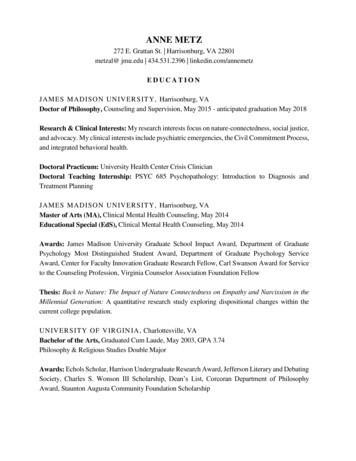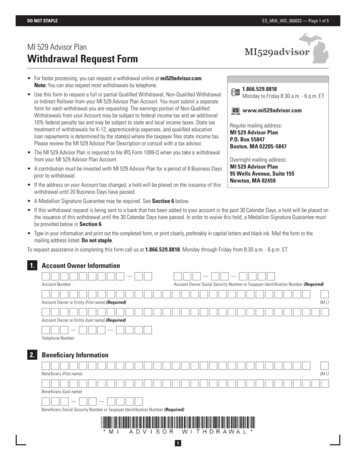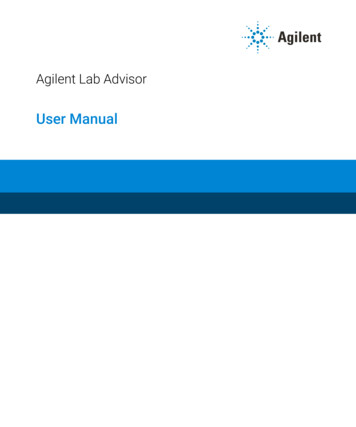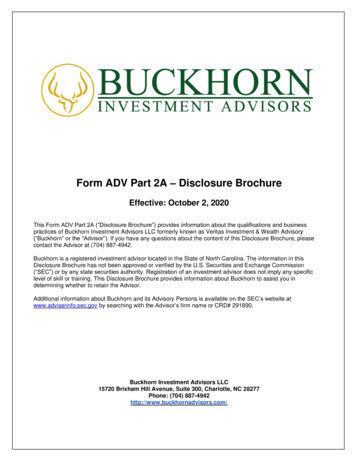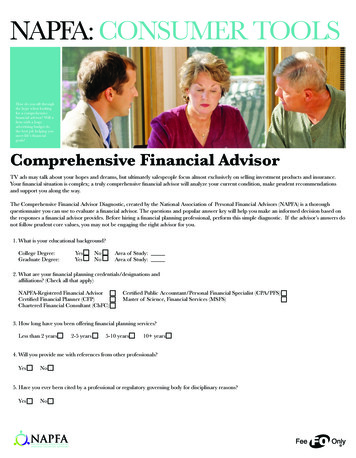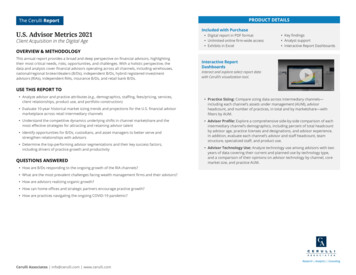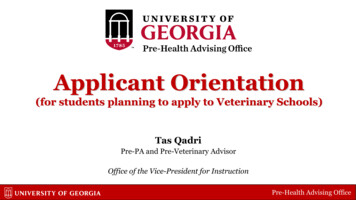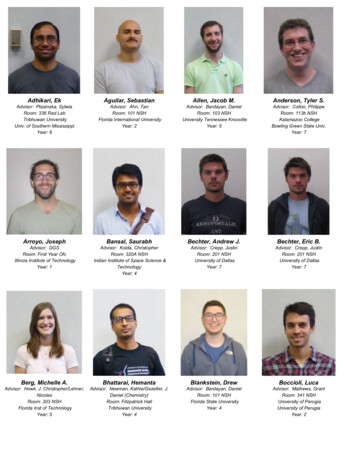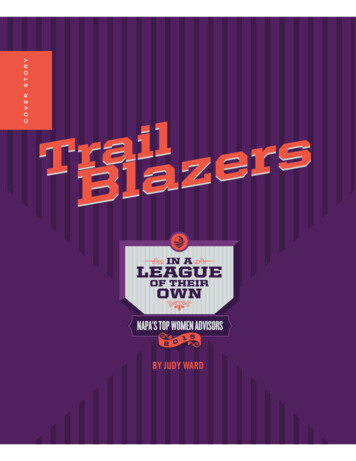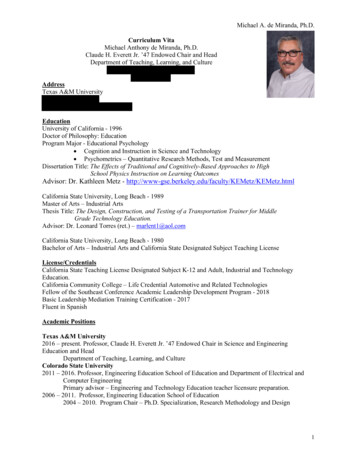
Transcription
Michael A. de Miranda, Ph.D.Curriculum VitaMichael Anthony de Miranda, Ph.D.Claude H. Everett Jr. ’47 Endowed Chair and HeadDepartment of Teaching, Learning, and CultureAddressTexas A&M UniversityEducationUniversity of California - 1996Doctor of Philosophy: EducationProgram Major - Educational Psychology Cognition and Instruction in Science and Technology Psychometrics – Quantitative Research Methods, Test and MeasurementDissertation Title: The Effects of Traditional and Cognitively-Based Approaches to HighSchool Physics Instruction on Learning OutcomesAdvisor: Dr. Kathleen Metz - htmlCalifornia State University, Long Beach - 1989Master of Arts – Industrial ArtsThesis Title: The Design, Construction, and Testing of a Transportation Trainer for MiddleGrade Technology Education.Advisor: Dr. Leonard Torres (ret.) – marlent1@aol.comCalifornia State University, Long Beach - 1980Bachelor of Arts – Industrial Arts and California State Designated Subject Teaching LicenseLicense/CredentialsCalifornia State Teaching License Designated Subject K-12 and Adult, Industrial and TechnologyEducation.California Community College – Life Credential Automotive and Related TechnologiesFellow of the Southeast Conference Academic Leadership Development Program - 2018Basic Leadership Mediation Training Certification - 2017Fluent in SpanishAcademic PositionsTexas A&M University2016 – present. Professor, Claude H. Everett Jr. ’47 Endowed Chair in Science and EngineeringEducation and HeadDepartment of Teaching, Learning, and CultureColorado State University2011 – 2016. Professor, Engineering Education School of Education and Department of Electrical andComputer EngineeringPrimary advisor – Engineering and Technology Education teacher licensure preparation.2006 – 2011. Professor, Engineering Education School of Education2004 – 2010. Program Chair – Ph.D. Specialization, Research Methodology and Design1
Michael A. de Miranda, Ph.D.2004 – 2009. Co-Director – Research and Development Center for the Advancement of StudentLearning2003 - 2006. Associate Professor, School of Education1998 – 2003. Associate Professor, Technology Education and TrainingDepartment of Manufacturing Technology and Construction ManagementColorado State UniversityCalifornia State University, Los Angeles1998 - Associate Professor, Manufacturing and Industrial TechnologyCalifornia State University, Los AngelesCollege of Engineering, Computer Science, and Technology1993 - 1997. Assistant Professor, Manufacturing and Industrial TechnologyCalifornia State University, Los AngelesCollege of Engineering, Computer Science, and Technology1993 – 1998 Coordinator of Technology Teacher Education ProgramPublic School K-121991- 1993. Secondary Education - TeacherTechnology Core and Pre-Engineering, Department ChairmanTechnology EducationTemescal Canyon High SchoolLake Elsinore Unified School District, Lake Elsinore, CA1986 – 1991. Secondary Education – TeacherManufacturing Technology and Department ChairElsinore High SchoolLake Elsinore Unified School District, Lake Elsinore, CA1983 – 1985. Secondary Education - TeacherDepartment of TechnologyLa Serna High SchoolWhittier Union High School District, Whittier, CA1980 – 1983. Associate Professor, Vocational EducationDepartment of Occupational EducationCompton Community CollegeCompton, CAUniversity Level Teaching Areas of Specialization (Courses Taught)1. Reasearch Methodology and Design Courses Introductory statistics (descriptive and inferential) Mesurement concepts – (Correlation, regression, principles of measurement) Analysis of variance (ANOVA and MANOVA) Undergraduate honors research2. Engineering and Technology Teaching Methods Courses Secondary Teaching Methods - Engineering and Technology Education Curriculum design and evaluation Introduction to engineering design3. Engineering and Industrial and Technology Education Technical Courses Taught Introduction to manufacturing materials and processes Team problemsolving and communication in industry Design drafting, CAD Technology applications in technology education Advanced materials and processes, CNC and precision machining Welding and advanced material joining processes2
Michael A. de Miranda, Ph.D.ScholarshipRefereed Journal Articles* Publication with graduate students or post doctoral fellows supervised.*Norouzian, R., de Miranda, M. A., & Plonsky, L. (2019). A Bayesian approach to measuring evidence inL2 research: An empirical investigation. Modern Language Journal, 103(1), 248-261. Available on line modl.12543*Norouzian, R., de Miranda, M. A., & Plonsky, L. (2018). The Bayesian revolution in second languageresearch: An applied approach. Language Learning, 64(4), 1032-1075.doi:10.1111/lang.12310 Available on line at 2310Maciejewski, A. A., Chen, T. W., Byrne, Z. S., de Miranda, M. A., Mcmeeking, L. B. S., Notaros, B. M.,& Rosales, A. H. (2017). A holistic approach to transforming undergraduate electrical engineeringeducation. IEEE Access, 5, 8148-8161. Available 1011/*Al Salami, M. K., Makela, C. J., & de Miranda, M. A. (2017). Assessing changes in teachers’ attitudestoward interdisciplinary STEM teaching. International Journal of Technology and DesignEducation, 27(1), 63-88.*Hernandez, P. R., *Bodin, R., *Elliott, J. W., *Ibrahim, B., Rambo-Hernandez, K. E., Chen, T. W., & deMiranda, M. A. (2014). Connecting the STEM dots: measuring the effect of an integrated engineeringdesign intervention. International Journal of Technology and Design Education, 24(1), 107-120.de Miranda, M. A. and Miyakawa, H. (2013). Taxonomic Analysis: A Foundation for the Design andDevelopment of Safety and Health Curriculum in Engineering and Technology Education. Journal of theJapanese Society for Technology Education.*Cumming, J. M. and de Miranda, M. A. (2012). Reducing Retroactive Interference Through the Use ofDifferent Encoding Techniques: An exploration of pre-test/post-test analysis. International Journal ofHigher Education. 1 (1) 22-27. doi: 10.5430/ijhe.v1n1p22 Available athttp://dx.doi.org/10.5430/ijhe.v1n1p22*Fantz, T. D., Siller, T. J. & de Miranda, M. A. (2011). Knowing Pre-Collegiate Factors Influencing theSelf-Efficacy of Engineering Students. Journal of Engineering Education. 100 (3) 604-623. Available athttps://ratings.asee.org/2011/July/09.pdf*Fantz, T. D., de Miranda, M. A., and Siller, T. J. (2010). Knowing What Engineering andTechnology Teachers Need to Know: An analysis of pre-service teachers engineering design problems.International Journal of Technology and Design Education DOI: 10.1007/s10798-010-9121-9Tobet, S. A, Henry, C. S., de Miranda, M. A., and Chen, T. (2009). A Multi-disciplinary Research andTeaching Program in Biomedical Engineering for Discovery and Understanding of Cell Communication.Slovenian Veterinary Research, 47(4)*Phillips, K. R., de Miranda, M. A., & Shin, J. (2009). Pedagogical Content Knowledge and IndustrialDesign Education Journal of Technology Studies 35 (2) 47-55.de Miranda, M. A. (2008). Pedagogical Content Knowledge and Engineering and Technology TeacherEducation: Issues for thought. Journal of the Japanese Society of Technology Education 50 (1) 17-26.3
Michael A. de Miranda, Ph.D.*Clapp, D., Shuler, S., Nobe, M., de Miranda, M. & Nobe, M. E. (2007). Capital Equipment Acquisitionin Heavy Construction. International Journal of Construction Education and Research. 3 (3) 159-178.Siller, T.J., de Miranda, M.A., Whaley, D.C. (2007). Engineering and Education Partnership: Combininga BS degree in engineering science with a technology education teaching license. The InternationalJournal of Engineering Education.23 (1) 58-64.de Miranda, M. A., Miyakawa, H. (2005). Technology Education: 25 years of progress. Bulletin of AichiUniversity of Education .27 (3) 127-142.de Miranda, M. A. (2004). The Grounding of a Discipline: Cognition and instruction in engineering andtechnology education. International Journal of Technology and Design Education.14 (1) 61-77. Availableat d, J. E., Senior, B. A. & de Miranda, M. A. (2002). Service Learning: Implications forTechnology Studies. Journal of Technology Studies. 28 (1) 52-58.Folkestad, J. E., de Miranda, M. A. (January, 2002). Impact of Screen Capture-Based Technology onStudent Comprehension of CAD Software principles. Journal of Industrial Technology. 18 (1) 2-7.*Griffith, S. and de Miranda (2001). Computer upgrade tips for the technology teacher. Journal of theInternational Technology Education Association. 60 (5) 27-31.de Miranda, M. A., Folkestad, J. E. (2000). Linking cognitive science theory and technology educationpractice: A powerful connection not fully realized. Journal of Industrial Teacher Education. 37 (4) 1-12.*Smith, F. G. and de Miranda, M. A. (2000). Build, draw, build: A lesson in contextual learning. Ties,6, 4-7.Folkestad, J. E. and de Miranda, M. A. (2000). Industrial advisory committee or action committee.Journal of Industrial Technology. 16 (3) 2-8. [On-line]. Available: http://www.nait.orgde Miranda, M. A., and Folkestad, J. E. (2000). Current perspectives on technology education in theUnited States. Connect. [On-line]. Available: http://www.unesco.orgUnited Nation Educational, Scientific, and Cultural Organization. NY, NY.*Clatterbaugh, Z. and de Miranda, M. A. (2000). Building a future for technology studies programs.Tech Directions. 60 (1) 22-23.*Sommerfeld, R. C., *Kissel, K., *Hageman, R. and de Miranda, M. A. (2000). Silk screening across thecurriculum: Making connections among disciplines through contextual learning and simple process.Tech Directions. 59 (10) 30-32.de Miranda, M. A., Lipton, E. B. (1998). A primer on mentoring. Journal of Technology Studies. 24 (1)42-44.de Miranda, M. A., Miyakawa, H., (1997). Technology education in the United States: A brief overview.Journal of the Japanese Society of Technology Education.4
Michael A. de Miranda, Ph.D.de Miranda, M. A., Miyakawa, H., (1996). Technology Education in California: An educationalcontinuum. Special Edition Frontiers in Technology Education, 2 (1), 53-56. Journal of the JapaneseSociety of Technology Education: Tokyo, Japan.de Miranda, M. A., (1996). A cross-curricular credit system for technology education. Technology Bank.Reston, VA: International Technology Education Association.de Miranda, M. A., (1995, April). A cross-curricular model for technology education: A minds onapproach for teachers and students. California Industrial and Technology Education Association, 49(4),21-22.Edited Booksde Miranda, M. A., Williams, P. J., Miyakawa, H. and Lee, L. S. (Eds.) (2004). Beyond Tomorrow:International cooperation in technology education. Kariya-City, Japan: Aichi University of EducationPress.Refereed Chapters in Books:de Miranda, M. A. (2017). Pedagogical Content Knowledge for Technology Education In M. J. de Vries(Ed.), Springer International Handbooks of Education: Handbook of technology education (pp. 685-698).Netherlands: Springer International Publishing. ISBN: 978-3-319-38889-2de Miranda, M. A., Troxell, W., Siller, T. J., Iversen, E. (2008). In. R.L. Custer & T.L. Ereksen (Eds.),Engineering and Technology Education (pp. 133-157). Woodland Hills, CA: Glencoe McGraw/Hillde Miranda, M. A. (2007). Social Aspects of Learning. In M. de Vries, R. L. Custer, J. Dakers & G.Martin (Eds.), Analyzing Best Practices in Technology Education (pp. 221-234). Rotterdam, TheNetherlands: Sense Publishers.de Miranda, M. A. (2005). Best Practice. In G.E. Martin and C. Martin (eds.) Best Practices forTechnology Education: A compilation of 21st century best practices in technology education.Technical Foundation of America; San Marcos, TX.de Miranda, M. A. (2004). International Cooperation in Technology Education: Case Study Egypt, Chile,and the West Indies (Belize). de Miranda, M. A., Williams, P. J., Miyakawa, H. and Lee, L. S. (Eds.).Beyond Tomorrow: International Cooperation in Technology Education. Kariya-City, Japan: AichiUniversity of Education Press.de Miranda, M. A., (2004). Biotechnology Ethics. In R. B. Hill (ed.), Ethics in Technology Education.Council on Technology Teacher Education 54th Annual Yearbook 2003. Glencoe; Peoria, IL.de Miranda, M. A., (2004). Medical Technology Ethics. In R. B. Hill (ed.), Ethics in TechnologyEducation. Council on Technology Teacher Education 54th Annual Yearbook 2003. Glencoe; Peoria, IL.de Miranda, M. A. (2003). Implementing Change in Technology Education: New perspectives, newquestions, new model. In G. Martin and H. Middleton (Eds.), Perspectives on InternationalCooperation in Technology Education. Brisbane, Australia: Technical Foundation of America and theCenter for Technology Education Research Griffith University.de Miranda, M. A. (2002). Technology Education in the United States. In E. Lipton (ed.), Models andVariables for Articulated Programs in the United States. Los Angeles: Center for Technology Education,California State University, Los Angeles.5
Michael A. de Miranda, Ph.D.de Miranda, M. A., (2000). Technology Education is Powerful Teaching. In E.G. Martin (ed.),Technology Education for the 21st Century. Council on Technology Teacher Education 50th AnnualYearbook 2000. Glencoe; Peoria, IL.de Miranda, M. A., (1999). Technology Education and the Cognitive Sciences: A powerful connectionbetween theory and practice. In W. E. Theuerkauf and M. J. Dyrenfurth (eds.), International Perspectiveson Technological Education: Outcomes and Futures. Braunschweig/Ames; Germany.Non-Refereed Journal Articles and Monographsde Miranda, M. A. (1998). Powerful teaching. In de Miranda, M. A. (Ed.) Instructionally Speaking,8(5), 2-3.de Miranda, M. A., (1995, Fall). Focus on technology. Instructionally Speaking, 6(2), 5.de Miranda, M. A., (1994).Manufacturing Technology: Where the future may lead us.California Industrial and Technology Education Association. Sacramento: CABurns, R. B., Mason, D., & de Miranda, M. A., (1993).How teachers and students are assigned to combination grade classroomsJournal of the California Educational Research Cooperative, University of California Press; Riverside,CA.Dahl, R., de Miranda, M. A., Gray, B., Lipton, E. B., Phillips, K., et al. (Eds.). (1993).Meeting the Educational Challenges of the 21st Century, California Industrial and Technology EducationAssociation; Sacramento, CA.Refereed Proceedings Published*Deuermeyer, E. & de Miranda, M. A. (2019, June) Scale Development for Measuring iDesign ContentConnections in Pre-Service STEM Teachers. Paper published and presented at the 37th Pupils AttitudesTowards Technology (PATT) Conference, University of Malta; Msida, Malta. ISBN: 9 789995 714796;p.133-144. Available at https://www.iteea.org/File.aspx?id 157700&v e94e5d51*Norouzian, R., de Miranda, M. A. (2019, March). How many participants do I need: An alternativemethod of sample size planning in L2 research. Paper presented at the annual meeting of the AmericanAssociation for Applied Linguistics (AAAL 2019), International Conference, Atlanta, Georgia, USA.de Miranda, M. A., *Norouzian, R., & Plonsky, L. (2019, March). Why Bayesian methods in L2Research: A practical guide. Paper presented at the annual meeting of the American Association forApplied Linguistics (AAAL 2019), International Conference, Atlanta, Georgia, USA.*Norouzian, R., de Miranda, M. A. (2019, April). Data size planning for multifactor ANOVA designs viaadequately narrow confidence intervals for partial eta-squared. Paper presented at the annual meeting ofthe American Educational Research Association (AERA 2019), International Conference, Toronto,Canada.*Deuermeyer, E. & de Miranda, M. A. (2018, June). STEM Associational Fluency: The cross-trainingof elementary and middle grade math, science, and engineering pre-service teachers. Paper published andpresented at the 36th Pupils Attitudes Towards Technology (PATT) Conference, Technology EducationResearch Group, Athlone Institute of Technology; Athlone, Ireland. ISBN 978-1-5272-2507-7, eISBN978-1-5272-2508-4; p.103-115. Available at https://www.iteea.org/File.aspx?id 157698&v 611c2ad16
Michael A. de Miranda, Ph.D.*Ibrahim, B., de Miranda, M. A., Lashari, T. A., & Siller, T. J. (2017, November). Teamwork andEngineering Design Outcomes: Examining the Relationship Among Engineering Undergraduate Students.2017 7th World Engineering Education Forum (WEEF) p. 628-635. IEEE. DOI:10.1109/WEEF.2017.8467056Available at 056*Ibrahim, B., de Miranda, M. A., & Siller, T. J. (2017). The correlation between creativity andengineering knowledge among engineering undergraduate students. 2016 IEEE 8th InternationalConference on Engineering Education (ICEED). doi:10.1109/iceed.2016.7856090/p. 38-42.de Miranda, M. A. (2017, June). Impact of Long-Term Design Problems in a Team Based Context onStudent iSTEM Associational Fluency. Paper published and presented at the 34th Pupils Attitudes TowardsTechnology (PATT) Conference, Philadelphia, Pennsylvania. Available athttps://www.iteea.org/File.aspx?id 115739&v 21dfd7aCapraro, M. M., Capraro, R. M., & de Miranda, M. (2017). The hidden supports of high schoolengineering and technology science fair winners. Paper presented at the seventy-ninth conference of theInternational Technology and Engineering Educators Association, Dallas, TX. Retrievedfrom https://www.iteea.org/39488.aspx.de Miranda, M. A., & Rambo-Hernandez, K. E., & *Hernandez, P. R. (2016, June), Measuring StudentContent Knowledge, iSTEM, Self Efficacy, and Engagement through a Long-Term Engineering DesignIntervention Paper presented at 2016 ASEE Annual Conference & Exposition, New Orleans, Louisiana.10.18260/p.25694Rosales, A. H., & Leland, A. M., & Notaros, O., & Toftness, R. F., & Siller, T. J., & De Miranda, M. A.,& Cook, A., & Reese, M. D., & Byrne, Z., & Weston, J. W., & Maciejewski, A. A. (2016, June),Preliminary Work on Weaving Professionalism Throughout the Engineering Curriculum Paper presentedat 2016 ASEE Annual Conference & Exposition, New Orleans, Louisiana. 10.18260/p.25946Maciejewski, A. A., Chen, T. W., de Miranda, M. A., and Byrne, Z. (2016, April). RevolutionizingEngineering Departments at Colorado State University and Beyond. AAAS/NSF Envisioning the Futureof Undergraduate STEM Education: Research and Practice , A. A., Chen, T. W., de Miranda, M. A., and Byrne, Z. (2016, April). Throwing AwayCourses to Reinvent the Undergraduate Engineering Experience. AAAS/NSF Envisioning the Future ofUndergraduate STEM Education: Research and Practice Symposium. http://www.cvent.com/d/grqgy2de Miranda, M. A., *Hernandez, P., and Rambo-Hernandez, K. (2014). How InterdisciplinaryEngineering and Technology Design and Making Projects Impact Students and Classrooms forSustainable STEM Education. UNESCO World Conference on Education for Sustainable Development.Proceeding, Nagoya, Japan.de Miranda, M. A. and Miyakawa, H. (2012, December). Taxonomic Analysis: A Foundation for theDesign and Development of Safety and Health Curriculum in Engineering and Technology Education.55th Annual Conference of the Japanese Society for Technology Education, Kyoto, Japan.*Fantz, T. D., de Miranda, M. A. (2010, October). Where the Engineering Pipeline Begins: Effects of precollegiate avocations on engineering student self-efficacy 9th Annual ASEE Global Colloquium onEngineering Education, American Society for Engineering Education, Singapore7
Michael A. de Miranda, Ph.D.de Miranda, M.A. (2008, November). Engineering Education and the Teacher in the Classroom: Reporton progress of the engineering education teacher preparation program at Colorado State University. 2008Global Workshop on Nano Science in Engineering Education. National Science Foundation Center forTeaching and Learning in Nano-Science in Engineering Education, Northwestern University.de Miranda, M.A. (2007, November). Pedagogical Content Knowledge and Engineering and TechnologyTeacher Education: Issues for thought. 94th Annual Meeting of the Mississippi Valley Technology TeacherEducation Conference. Chicago, ILde Miranda, M. A. (2003, July). International Cooperation in Technology education: Case Study Egypt,Chile, and the West Indies (Belize). In H. Miyakawa (Ed.), International Symposium on EducationalCooperation for Industrial technology Education (pp.115-128). Kariya-City, Japan: Aichi University ofEducation Press.de Miranda, M. A. (2002, October). Toward an Epistemology of Learning, Cognition, and Instruction inTechnology Education: A framework of shared characteristics for an immature field. In T. Erickson(Chair), Creativity in technology education. 89th annual Mississippi Valley Technology TeacherEducation Conference, St. Louis, MO, USA.de Miranda, M. A. (2000, July). Team Problem Solving and Leadership in Technology Education: Astudy of group dynamics in technology classrooms. Japanese Society for Technology Education, 43rdAnnual Conference, Fukui, Japan.Lipton, E. B. and de Miranda, M. A. (2000, April). Using Technology Standards. 62th AnnualConference of the International Technology Education Association, Salt Lake City, UT.de Miranda, M. A. (2000, April). Teaching Innovation in Technology Education. 62nd AnnualConference of the International Technology Education Association, Salt Lake City, UT.Lipton, E. B. and de Miranda, M. A. (2000, March). Strategies for Developing Effective Teaming inTechnology. 71st Annual Conference of the California Industrial Technology Education Association,Pasadena, CA.de Miranda, M. A. and Lipton, E. B. (1999, March). Teaching Teaming in Technology Education. 61stAnnual Conference of the International Technology Education Association, Indianapolis, IN.de Miranda, M. (1998, September). Technology education and the cognitive sciences: A powerfulconnection between theory and practice. International Working Seminar for Scholars in TechnologyEducation, George Washington University; Washington, DC.de Miranda, M. A., Jones, M. E., Motherhead, T., Tsosie, T. (1998, March). Design and Technology: Areport on the study tour of the United Kingdom, 1997. 60th Annual Conference of the InternationalTechnology Education Association, Dallas, TX.de Miranda, M. A. (1997, October). Quality Processes: ISO Standards and Active Knowledge Modelingfor Small and Medium Sized Suppliers to the Aircraft Industry. World Aviation Congress and Exposition,Anaheim, CA.de Miranda, M. A. (1997, March). What Really Happens in Technology Classrooms: A report onresearch? 59th Annual Conference of the International Technology Education Association,Tampa, FL.8
Michael A. de Miranda, Ph.D.de Miranda, M. A., Maurizio, D. (1997, March). Technology Core in California: A five-year report.59th Annual Conference of the International Technology Education Association,Tampa: FL.Merrill, C., de Miranda, M. A. (1997, March). Deliberation in the Classroom: A key to powerfulteaching. 59th Annual Conference of the International Technology Education Association. Tampa: FL.de Miranda, M. A., Smith, D., (1997, February). ISO9000 / Metis: Linking education and businessthrough consortia cooperatives. El Cloegio de la Frontera Norte, Symposia de el Departamento deEstudios en Salud Publica. Rosarito/Tijuana, Baja California, Mexico. (Written in Spanish and English)de Miranda, M. A., (1996, December). Integrated technology learning activities. California Industrialand Technology Education Association, Palm Springs: CA.de Miranda, M. A., Smith, D., (1996, December). ISO9000 / Metis: Executive overview. El Cloegio dela Frontera Norte, Symposia de el Departamento de Estudios en Salud Publica. Rosarito/Tijuana, BajaCalifornia, Mexico. (Written in Spanish and English)de Miranda, M. A., Miyakawa, H., (1996). Technology education in the United States. Proceedings ofthe Mie Branch of the Japanese Society of Technology Education, 9, 1-2. Mie, Japan.Lipton, E. B., de Miranda, M. A. (1996). Mentoring to develop a highly qualified and diverse industrialtechnology faculty. Proceedings of the 29th Annual Conference of the National Association of IndustrialTechnology, 29, 49.de Miranda, M. A., (1995). Cross-curricular credit system for technology education. [PublishedProceedings]. Proceedings of the 57th Annual Conference of the International Technology EducationAssociation, 57, 74-78.de Miranda, M. A., Lipton, E. B., & Cain, R. E. (1995). Mentoring for diversity in technology education.Proceedings of the 57th Annual Conference of the International Technology Education Association, 57,88-92.Lipton, E. B., de Miranda, M. A. (1995). Models and variables for successful articulation of industrialand technology education programs in the United States [Published Proceedings]. Proceedings of the 28thAnnual Conference of the National Association of Industrial Technology, 28, 36.Peer Reviewed Journal Abstracts Acceptedde Miranda, M. A., Hernandez, P. R., Rambo-Hernandez, K. E. (2015, October). Measuring StudentContent Knowledge, iSTEM, Self Efficacy, and Engagement Through a Long Term Engineering DesignIntervention. American Society for Engineering Education.Rosales, A., Siller, T. J., de Miranda, M. A. (2015, October). Preliminary Work on WeavingProfessionalism throughout the Engineering Curriculum. American Society for Engineering Education.Maciejewski, A. A., Chen, T. W., de Miranda, M. A., and Byrne, Z. (2015, October). RevolutionizingEngineering Departments at Colorado State University and Beyond. AAAS/NSF Envisioning the Futureof Undergraduate STEM Education: Research and Practice , A. A., Chen, T. W., de Miranda, M. A., and Byrne, Z. (2015, October). Throwing AwayCourses to Reinvent the Undergraduate Engineering Experience. AAAS/NSF Envisioning the Future ofUndergraduate STEM Education: Research and Practice Symposium. http://www.cvent.com/d/grqgy29
Michael A. de Miranda, Ph.D.de Miranda, M. A. and Miyakawa, H. (2012, August). Taxonomic Analysis: A Foundation for the Designand Development of Safety and Health Curriculum in Engineering and Technology Education. Journal ofthe Japanese Society for Technology Education.Peer Reviewed and Invited PresentationsCapraro, M. M., Capraro, R. M., & DeMiranda, M. (2017, March). The hidden supports of high schoolengineering and technology science fair winners. Accepted for presentation at the 2017 InternationalTechnology and Engineering Educators Association, Dallas, TX.de Miranda, M. A. and Miyakawa, H. (2012, December). Taxonomic Analysis: A Foundation for theDesign and Development of Safety and Health Curriculum in Engineering and Technology Education.55th Annual Conference of the Japanese Society for Technology Education, Kyoto, Japan.de Miranda, M. A. (2012, December, Invited). Connecting the STEM Dots: An analysis of a long-termengineering design intervention on student expectancy, utility, and perseverance value. InvitedDistinguished Lecture. Aichi University of Education, Cariya-City, Aichi Japan.de Miranda, M. A. (2012, October). Multidisciplinary STEM Content Connections in Students Engagedin a Long-Term Integrated Engineering Design Problem. Annual Conference of the National Network forEducational Renewal. Denver, Coloradode Miranda, M. A., Wagner, D., McDonnell, K. (2012, March). Engineering Design Across STEMDisciplines: Interdisciplinary Student Teams at Multiple High Schools Collaborate to Solve a SignificantEngineering Design Problem. National Science Foundation Annual Graduate STEM Fellows in K-12Education Conference. Washington, DC.Plugge, P. W., de Miranda, M. A., Hauck, A. J. (2003). Comparison of Risk Communication andManagement Factors Associated With Large Design-Build Infrastructure Projects. Journal of theAssociated Schools of Construction.de Miranda, M. A. (2000, June). Future schools. Symposium for the Future Direction of EgyptianEducation: Egyptian Ministry of Education. Cairo, Egypt.de Miranda, M. A. (2000, March). Digital kids Analog schools What’s gone wrong? TechnologyEducation Seminar: Egyptian Ministry of Education. Cairo, Egypt.de Miranda, M. A., Sheafor, B. and Grosse, L. (2000, November). Rationale and structure for the studyof technology. Symposia on the Formation of Teachers for the 21st Century. Copiapo, Chile.de Miranda, M. A., and Schmidt, F. (1999, November). Design briefs for power, energy andtransportation technology. Rocky Mountain States Conference. Fort Collins, Colorado.de Miranda, M. A., Livingston, C. (1999, October). Colorado School to Career Briefs: Connectingcommunities’ classrooms and careers. Colorado School to Career Conference. Keystone, Colorado.de Miranda, M. A., and Jaouen, S. (1998, November). Team building activities for technology teachers.Rocky Mountain States Conference. Fort Collins, Colorado.de Miranda, M. A., and Jaouen, S. (1998, October). Team building activities for technology teachereducators. Mountain States Conference. Alta, Utah.10
Michael A. de Miranda, Ph.D.de Miranda, M. A. (1998, November). Technology education: An educational continuum. RockyMountain States Conference. Fort Collins, Colorado.Otherde Miranda, M. A. and Livingston, C. (2001). Framework for the Study of Technology in Colorado.Colorado Community College and Occupational Education System. Denver, CO.de Miranda, M. A. and Livingston, C. (2000). Colorado School to Career Briefs. Colorado CommunityCollege and Occupational Education System. Denver, CO.de Miranda, M. A. et al. (1999). Colorado Technology Education Standards. Colorado CommunityCollege and Occupational Education System. Denver, CO.de Miranda, M. A. et al. (1995). California State Model Curriculum and Career Path Standards,Technology Core. California State Printing Office: Sacramento, CAde Miranda, M.
Public School K-12 . 1991- 1993. Secondary Education - Teacher Technology Core and Pre-Engineering, Department Chairman Technology Education Temescal Canyon High School Lake Elsinore Unified School District, Lake Elsinore, CA . 1986 - 1991. Secondary Education - Teacher Manufacturing Technology and Department Chair Elsinore High School
